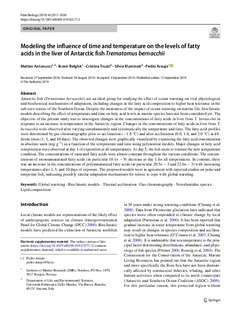| dc.description.abstract | Antarctic fish (Trematomus bernacchii) are an ideal group for studying the effect of ocean warming on vital physiological and biochemical mechanisms of adaptation, including changes in the fatty acid composition to higher heat tolerance in the sub-zero waters of the Southern Ocean. Despite the awareness of the impact of ocean warming on marine life, bioclimatic models describing the effect of temperature and time on fatty acid levels in marine species have not been considered yet. The objective of the present study was to investigate changes in the concentrations of fatty acids in liver from T. bernacchii in response to an increase in temperature in the Antarctic region. Changes in the concentrations of fatty acids in liver from T. bernacchii were observed after varying simultaneously and systematically the temperature and time. The fatty acid profiles were determined by gas chromatography prior to acclimation (− 1.8 °C) and after acclimation (0.0, 1.0, and 2.0 °C) at different times (1, 5, and 10 days). The observed changes were graphically visualized by expressing the fatty acid concentration in absolute units (mg g−1) as a function of the temperature and time using polynomial models. Major changes in fatty acid composition were observed at day 1 of exposition at all temperatures. At day 5, the fish seem to tolerate the new temperature condition. The concentrations of saturated fatty acids were almost constant throughout the various conditions. The concentrations of monounsaturated fatty acids (in particular 18:1n − 9) decrease at day 1 for all temperatures. In contrast, there was an increase in the concentrations of polyunsaturated fatty acids (in particular 20:5n − 3 and 22:6n − 3) with increasing temperatures after 1, 5, and 10 days of exposure. The proposed models were in agreement with reported studies on polar and temperate fish, indicating possibly similar adaptation mechanisms for teleost to cope with global warming. | nb_NO |
